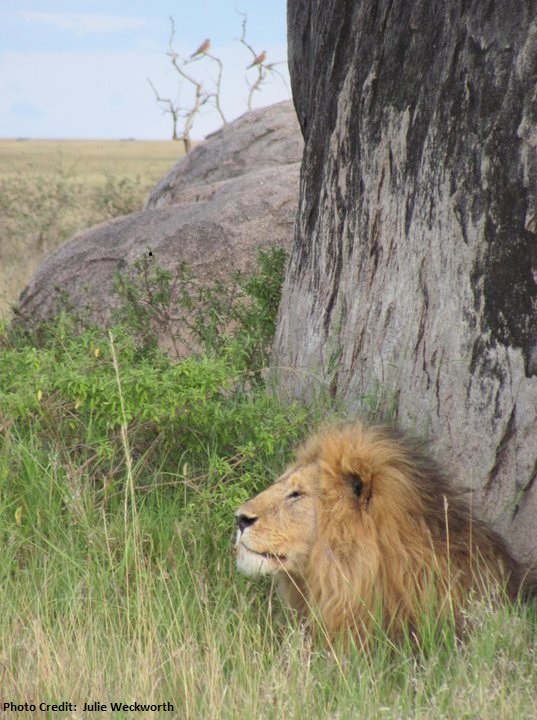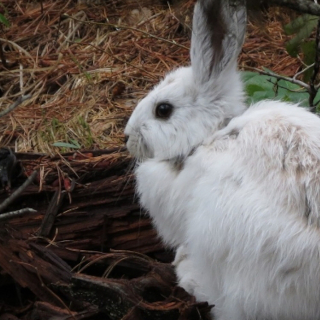Julie Weckworth
 My Contact Info
My Contact Info
Address:
32 Campus Drive
College of Forestry and Conservation, University of Montana
Missoula, MT 59812
Email: julie.weckworth [at] umontana.edu
Phone: (406) 223-3291
Click here for a copy of my CV
Dissertation research: Investigating ecological and evolutionary dynamics of Canine distemper virus in Serengeti carnivores to improve disease surveillance and management
More about my Research:
CDV cross-species transmission dynamics in a complex carnivore community
In 1994, an outbreak of CDV killed an estimated 1000 Serengeti lions in 7 months - 33% of this iconic population! Serological data and case reports suggest that the virus originated in a high-density domestic dog population to the northwest of Serengeti National Park and spread through wild carnivores in the reserve and into domestic dog populations on the east side of the park. Recent models support a hypothesis that multiple species likely allowed the virus to reach epidemic proportions in the lions and that within the lion population, inter-pride spread was best explained by multiple, repeated introductions of CDV by one or more species other than lions. An in depth understanding of transmission dynamics across multiple Serengeti species however is lacking. Whole genome sequences of CDVs and epidemiological data will be combined in this study to reconstruct pathways of transmission at a high resolution during this revealing epidemic. Knowledge of how CDV is transmitted to lions and how/if the virus is propagated within the lion population is key for designing intervention strategies to protect sensitive populations in the face of a lethal multi-host outbreak.
The big picture - Understanding patterns of CDV re-emergence in Serengeti lions
Although serological evidence pointed to domestic dogs as the origin of CDV in the 1994 outbreak, it is yet unclear if the population comprises a permanent maintenance reservoir in this system. Serengeti lions have been exposed to CDV on several occasions in the last 35 years. A recent model estimates that before 1994 lion exposure was cyclic and followed the cycle of exposure in domestic dogs – supporting a domestic dog reservoir hypothesis. However, after 1994 the cycles in lions became more frequent and unsynchronized from the domestic dog exposure cycles – suggesting a more complicated reservoir community. Our study will use phylodynamic analyses of whole genome sequence data to reconstruct the epidemiological history of CDV in the Serengeti system. Specifically, we address the question – are all lion exposures a result of independent spillover events from domestic dogs or has CDV been maintained by the wild carnivore community since the 1994 outbreak? Understanding the key determinants of spillover will improve our ability to predict and prevent CDV outbreaks in the Serengeti lion population.
The submicroscopic picture – the role of virus evolution in clinical outcome of CDV exposure in African lions and other big cats
Obviously, African lions are highly susceptible to CDV... but are they? Serological results show that the Serengeti lion population was exposed to CDV on several other occasions in addition to 1994 without any observed clinical symptoms of disease or increased mortality. Similarly, African lions in captivity on occasion build antibodies to CDV, a response to infection/exposure, without developing any symptoms. Whereas other times they have developed systemic CDV infection and died. These observations beg the question – what are key factors that determine the outcome of CDV spillover in lions? We will test the hypothesis that clinical CDV infection in African lions is driven by viral genotype by comparing whole genome sequences extracted from lions that suffered clinical infection to the whole genome sequences of wild type virus and virus from subclinically infected lions. In parallel the analysis will be extended to include tigers (Panthera tigris) and leopards (Panthera pardus) infected in two captive CDV outbreaks (1992 and 2013). Identifying a genetic signature that predicts clinical infection in African lions and other Panthera species will improve disease surveillance and risk assessment for small, vulnerable populations.
Acknowledgements
None of this work would be possible if not for the sheer brilliance of the scientists and institutions that have been involved in research and disease surveillance in the Serengeti over the last 2-3 decades, nor without the generosity of my funders. Many thanks to Tanzania National Parks, Tanzania Wildlife Research Institute, Ngorongoro Conservation Area Authority, the Tanzania Veterinary Laboratory Agency, Nelson Mandela African Institute of Science and Technology, the Serengeti Lion Project (University of Minnesota), the Carnivore Disease Project (University of Glasgow/Lincoln Park Zoo), the National Institutes of Health, the Animal Health and Diagnostic Center (Cornell University), In Sync Exotics Wildlife Rescue & Education Center, the Wildlife Conservation Society, the Texas Department of State Health Services, IDEXX Laboratories, GeneReach Biotechnology Corp., Dallas Animal Services, the Baker Institute (Cornell University), the Morris Animal Foundation, the National Science Foundation, University of Montana Wildlife Biology and Montana Ecology of Infectious Diseases programs.
